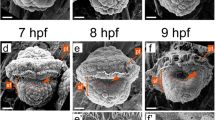Summary
In embryos of the equally cleaving marine gastropod Patella vulgata, the mesodermal stem cell is determined during the interval between the fifth and sixth cleavage by means of cellular interactions between one of the four vegetally located macromeres with the overlying animal micromeres. Shortly before and during this interaction phase an extracellular matrix (ECM) is present between the interacting cells. In this study the glycosylation-perturbing ionophore monensin was used to investigate the possible morphogenetic significance of the ECM. Incubation of 32-cell-stage Patella embryos in 10−6 M monensin results in radialized embryos in which none of the four macromeres interacts with the overlying animal micromeres. None of the macromeres is determined, therefore, to form mesoderm in such embryos. Trochophore larvae reared from these embryos retain their radial symmetry, as is indicated by the presence of four shell glands and four blastopore- or stomodeum-like invaginations in these larvae. The monensin-treated embryos probably secrete abnormal ECM that does not provide the proper conditions for the blastomeres to stretch and interact with the micromeres. Changes in intracellular ionic concentrations may also be involved.
Similar content being viewed by others
References
Arnolds WJA, van den Biggelaar JAM, Verdonk NH (1983) Spatial aspects of cell interactions involved in the determination of dorsoventral polarity in equally cleaving gastropods and regulative abilities of their embryos, as studied by micromere deletions in Lymnaea and Patella. Wilhelm Roux's Arch 192:75–85
Atkinson JW (1971) Organogenesis in normal and lobeless embryos of the marine prosobranch gastropod Ilyanassa obsoleta. J Morphol 133:339–352
Biggelaar JAM van den (1977) Development of dorsoventral polarity and mesentoblast determination in Patella vulgata. J Morphol 154:157–186
Biggelaar JAM van den, Guerrier P (1979) Dorsoventral polarity and mesentoblast determination as concomitant results of cellular interactions in the Mollusc P. vulgata. Dev Biol 68:462–471
Bissel MJ, Hall HG, Parry G (1982) How does the extracellular matrix direct gene expression? J Theor Biol 99:31–68
Busa WB, Nuccitelli R (1984) Metabolic regulation via intracellular pH. Am J Physiol 246:409–438
Clement AC (1952) Experimental studies on germinal localization in Ilyanassa. I. The role of the polar lobe in determination of the cleavage pattern and its influence in later development. J Exp Zool 121:593–626
Dongen CAM van (1976) The development of Dentalium with special reference to the significance of the polar lobe. VII. Organogenesis and histogenesis in lobeless embryos of Dentalium vulgare (da Costa) as compared to normal development. Proc K Ned Akad Wet Ser C 79:454–465
Duband JL, Thiery JP (1985) Adhesive molecules and their role during the ontogeny of the peripheral nervous system. In: Marthy HJ (ed) Cellular and molecular control of direct cell interactions. NATO ASI Series, vol 99. Plenum Press, New York, pp 85–118
Farquhar MG, Courtoy PJ, Lemkin MC, Kanwar YS (1982) Current knowledge of the functional architecture of the glomular basement membrane. In: Kuehn K, Schoene HH, Timpl R (eds) New trends in basement membrane research. 10th Workshop Conference Hoechst. Raven Press, New York, pp 9–29
Goldberg RL, Toole BP (1983) Monensin inhibition of hyaluronate synthesis in rat fibrosarcoma cells. J Biol Chem 258:7041–7046
Hascall VC, Hascall GK (1981) Proteoglycans. In: Hay ED (ed) Cell biology of extracellular matrix. Plenum Press, New York, pp 39–64
Jaffe LF (1979) Control of development by ionic currents. In: Cone RA, Dowling JE (eds) Membrane transduction mechanisms. Raven Press, New York, pp 199–231
Kajiwara T, Tanzer ML (1982) Undersulphated proteoglycans are induced by the ionophore monensin: study of possible mechanisms. Arch Biochem Biophys 214:51–55
Kühtreiber WM, van der Bent J, Dorresteijn AWC, de Graaf A, van den Biggelaar JAM, van Dongen CAM (1986) The presence of an extracellular matrix between cells involved in the determination of the mesoderm bands in embryos of Patella vulgata (Mollusca, gastropoda). Wilhelm Roux's Arch 195:265–275
Ledger PW, Tanzer ML (1984) Monensin — a perturbant of cellular physiology. TIBS 9:313–314
Ledger PW, Nishimoto SK, Hayashi S, Tanzer ML (1983) Abnormal glycosylation of human fibronectin secreted in the presence of monensin. J Biol Chem 258:547–554
Martindale MQ, Doe CQ, Morrill JB (1985) The role of animal-vegetal interaction with respect to the determination of dorsoventral polarity in the equal-cleaving spiralian, Lymnaea palustris. Wilhelm Roux's Arch 194:281–295
Neblock DS, Berg RA (1986) Decreased synthesis and increased intracellular degradation of newly synthesized collagen in freshly isolated chick tendon cells incubated with monensin. Biochemistry 25:6208–6213
Osborn JC, Duncan CJ, Smith JL (1979) Role of calcium ions in the control of embryogenesis of Xenopus. J Cell Biol 80:589–604
Reynolds ES (1963) The use of lead citrate at high pH as an electron-opaque stain in electron microscopy. J Cell Biol 17:208–212
Sanders EJ, Chokka P (1987) Monensin inhibits secretion of extracellular matrix and the spreading of mesoderm cells in the early chick embryo. J Cell Sci 87:389–398
Tartakoff AM (1983) Perturbation of vesicular traffic with the carboxylic ionophore monensin. Cell 32:1026–1028
Toole BP (1981) Glycosaminoglycans in morphogenesis. In: Hay ED (ed) Cell biology of extracellular matrix. Plenum Press, New York, pp 259–294
Toole BP, Goldberg RL, Chi Rosso G, Underhill CB, Orkin RW (1984) Hyaluronate-cell interactions. In: Trelstad RD (ed) The role of extracellular matrix in development. AR Liss, New York, pp 43–67
Verdonk NH, Cather JN (1983) Morphogenetic determination and differentiation. In: Verdonk NH, van den Biggelaar JAM, Tompa AS (eds) The mollusca, vol 3. Academic Press, New York, pp 215–252
Wal UP van der, Dohmen MR (1978) A method for the orientation of small and delicate objects in embedding media for light and electron microscopy. Stain Technol 53:56–57
Webb DJ, Charbonneau M (1987) Weak bases inhibit cleavage and embryogenesis in amphibians and echinoderms. Cell Differ 20:33–44
Yamada KM (1983) Fibronectin in cell interactions. In: Yamada KM (ed) Cell interactions and development: molecular mechanisms. Wiley, New York, pp 231–249
Author information
Authors and Affiliations
Rights and permissions
About this article
Cite this article
Kühtreiber, W.M., van Til, E.H. & van Dongen, C.A.M. Monensin interferes with the determination of the mesodermal cell line in embryos of Patella vulgata . Roux's Arch Dev Biol 197, 10–18 (1988). https://doi.org/10.1007/BF00376036
Received:
Accepted:
Issue Date:
DOI: https://doi.org/10.1007/BF00376036




